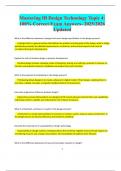Mastering IB Design Technology Topic 4:
100% Correct Exam Answers- 2025/2026
Updated
What is the difference between a design brief and a design specification in the design process?
A design brief is a general outline that defines the problem and the goals of the design, while a design
specification provides the detailed requirements, constraints, and technical aspects that must be
considered during the development.
Explain the role of iterative design in product development.
Iterative design involves repeating cycles of designing, testing, and refining a product to improve its
function and aesthetics based on feedback and analysis from each iteration.
What is the purpose of prototyping in the design process?
Prototyping allows designers to create a physical or digital model of their design, enabling them to
test ideas, validate concepts, and gather feedback before full production.
How does ergonomics influence product design?
Ergonomics ensures that products are designed to fit human physical characteristics and capabilities,
improving comfort, usability, and reducing the risk of injury during use.
What is a flowchart, and how is it useful in the design process?
A flowchart is a visual representation of a process or system, used to map out steps and decisions in
the design process to improve efficiency and clarify the workflow.
Describe the importance of sustainability in design technology.
Sustainability in design involves creating products that minimize negative environmental impacts by
considering resource use, energy consumption, and recyclability throughout their lifecycle.
What is the difference between primary and secondary research in design?
1
, Primary research involves collecting new, firsthand data through surveys, interviews, or experiments,
while secondary research involves analyzing existing data and sources to inform the design process.
How do designers address cultural considerations in product design?
Designers consider cultural preferences, traditions, and values to ensure products are appropriate
and appealing to users from different cultural backgrounds, enhancing usability and market success.
What are the key factors that influence the selection of materials in design?
Factors such as material properties (strength, durability, weight), cost, availability, environmental
impact, and suitability for the intended function of the product all play a role in material selection.
What is the significance of CAD (Computer-Aided Design) software in modern design technology?
CAD software enables designers to create detailed and precise digital models, visualize designs in 3D,
perform simulations, and make revisions quickly, streamlining the design process.
Explain the concept of user-centered design (UCD).
User-centered design focuses on creating products that meet the needs, preferences, and limitations
of end-users by involving them in the design process through feedback and testing.
What is the role of CAD in the production of product prototypes?
CAD allows for the creation of digital models that can be translated into physical prototypes through
technologies like 3D printing or CNC machining, providing a faster, more accurate process.
How do designers assess the environmental impact of a product during the design process?
Designers assess factors like material sourcing, energy use, manufacturing processes, and end-oflife
disposal to minimize the environmental footprint of a product through life cycle analysis.
What are the key stages in the product development process?
The key stages include idea generation, conceptual design, detailed design, prototyping, testing, and
production, with feedback loops at each stage to refine and improve the design.
2




